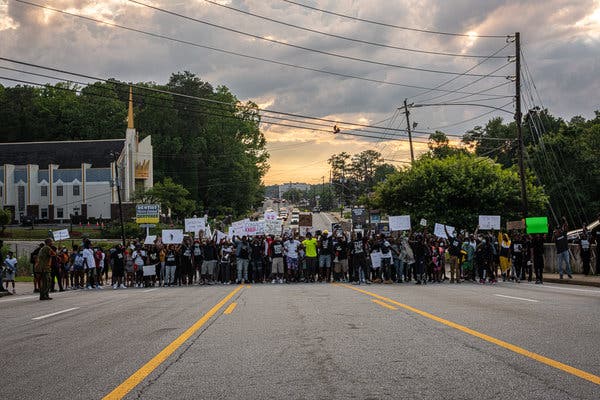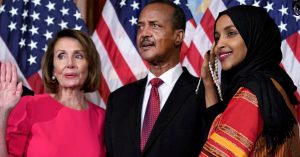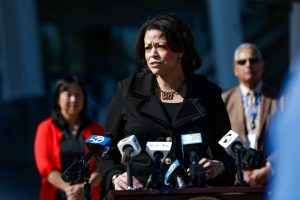Here’s what you need to know:
- The officer who shot Rayshard Brooks had been reprimanded over use of force in 2016.
- Trump plans an executive order on principles for police training and use of force.
- Almost 100 cities have used tear gas on protesters despite safety concerns.
- A man is shot during a protest of a statue honoring New Mexico’s conquistador.
- Social movements are often sanitized for the history books.
- New video in Manuel Ellis’s death shows a neck restraint being used.
- More than 2,000 black people were killed by white mobs during Reconstruction, a study says.
The officer who shot Rayshard Brooks had been reprimanded over use of force in 2016.
The former Atlanta Police Department officer who fatally shot an African-American man after a confrontation outside a fast-food restaurant had been issued a written reprimand in 2016 for another use-of-force incident involving the use of a firearm, according to records released by the department.
The disciplinary history of the former officer, Garrett Rolfe, who was fired this weekend after the shooting, does not include details of the 2016 use-of-force case, or a number of other incidents he was involved in since being hired in 2013.
These include four citizen complaints, which resulted in no disciplinary action, and five vehicle accidents, which resulted in an “oral admonishment” in 2014 and a written reprimand in 2018.
Mr. Rolfe’s record also includes an August 2015 episode involving the discharge of a firearm, but there is no record of any disciplinary action taken in that case.
The department also released a file that showed no previous disciplinary record for Devin Brosnan, the other officer who responded to the fast-food restaurant Friday night after an employee called 911 and complained that Rayshard Brooks, 27, appeared to be intoxicated and asleep, and was blocking the drive-through lane.
Officer Brosnan, who joined the force in June 2019, has been placed on administrative duties pending the outcome of an investigation.
The fatal shooting of Mr. Brooks prompted demonstrations throughout the weekend in Atlanta, including one on Saturday night in which protesters burned down the Wendy’s restaurant where the shooting occurred. The city’s police chief, Erika Shields, stepped down in the wake of the incident, and on Monday, Mayor Keisha Lance Bottoms announced major revisions to the department’s use-of-force policies.
Video recordings show the two officers engaged Mr. Brooks in a long conversation that appeared to be respectful, and gave him field sobriety and breathalyzer tests. The officers concluded that Mr. Brooks was intoxicated, and when they moved to handcuff him, Mr. Brooks resisted. The three men wrestled on the pavement, and Mr. Brooks emerged with one of the officer’s Tasers. He ran away and fired the Taser at Mr. Rolfe, who was chasing him close behind.
It was at that point that Mr. Rolfe shot him. An autopsy report showed Mr. Brooks was shot twice in the back.
The Fulton County district attorney, Paul Howard, is investigating the case, but has not yet made a determination as to whether the officers should be charged criminally. On Sunday, he told a CNN reporter that Mr. Brooks “did not seem to present any kind of threat to anyone, and so the fact that it would escalate to his death just seems unreasonable.”
Trump plans an executive order on principles for police training and use of force.
President Trump is expected to sign an executive order today that would begin a process of encouraging police departments to raise their standards for training and the use of force, even as some cities and states are moving to institute further-reaching and more immediate reforms in police practice.
Coming three weeks after the death of George Floyd, while protests over police violence against African-Americans continue across the country, Mr. Trump’s order is expected to have no immediate practical impact. A senior administration official who briefed reporters in a conference call on Monday said the order would feature “guiding principles” that must be translated into more specific federal action by the executive branch and through potential congressional legislation.
“We’re going to have some solutions,” Mr. Trump himself said on Monday. “We need great people in our police departments, and we have mostly great people.”
The official said the order would call for the most modern standards for police training and the use of force; information sharing among police departments to track officers who have been the subject of complaints as they move between jobs; and encouraging programs that support police officers with social workers and other professionals on calls involving issues like mental health and homelessness.
A second official said the executive order would not condition federal dollars on any such actions but would use money to “incentivize” action by police departments.
Meanwhile, in the wake of a fatal police shooting of a black man, Rayshard Brooks, in Atlanta on Friday, the Mayor of Atlanta, Keisha Lance Bottoms, announced a series of changes on Monday that would impose significant restrictions on when and how police officers can use force. A lawyer who has brought police brutality suits against the Atlanta Police Department, and whom Ms. Bottoms appointed to a mayoral task force on policing, Shean Williams, hailed her actions as a “substantial step toward actual change.”
Mr. Trump’s executive order, by contrast, earned advance praise from the National Fraternal Order of Police, the nation’s largest law enforcement labor organization, which said it had reviewed the language of the order and supported its goals and methodology.
“It strikes a great balance between the vital need for public and officer safety, and the equally vital need for lasting, meaningful, and enforceable police reform,” the organization said in a statement.
Mr. Trump’s signing event on Monday will be attended by police officers and representatives, along with the families of people who have been killed by police officers, one of the administration officials said, adding that its goal is to “turn the anger in the country into action” and “bring some unification and healing.”
Almost 100 cities have used tear gas on protesters despite safety concerns.
At least 96 law enforcement agencies — many in large cities — used some form of tear gas against civilians protesting police brutality and racism in recent weeks, according to an analysis by The New York Times. This brief period has seen the most widespread domestic use of tear gas against demonstrators since the long years of unrest in the late 1960s and early ’70s, according to Stuart Schrader of Johns Hopkins University, who studies race and policing.
“Thousands and thousands of utterly ordinary people who thought they were going to an ordinary protest event are finding themselves receiving a really aggressive police response,” he said. “That itself is a bit horrifying. The police have actually succeeded in making people more angry.”
Tear gas has long been used to disperse crowds during protests and riots, both nationally and internationally, despite being banned in warfare by the Chemical Weapons Convention.
If used appropriately, it drives people to flee the gas, which irritates their eyes, skin and lungs without causing serious, long-term injuries in most. But in cases where law enforcement misuses the agent, it can cause debilitating injuries.
The widespread use of tear gas has prompted pushback, with some lawmakers calling for a ban of its use in Massachusetts and New Orleans. Other cities, including Denver, Seattle, Dallas and Portland, Ore., have all temporarily banned the police from using tear gas.
A man is shot during a protest of a statue honoring New Mexico’s conquistador.
Gunfire broke out during a protest Monday night in Albuquerque to demand the removal of a statue of Juan de Oñate, the despotic conquistador of New Mexico whose image has become the latest target in demonstrations across the country aimed at righting a history of racial injustice.
As dozens of people gathered around a statue of Oñate, New Mexico’s 16th-century colonial governor, shouting matches erupted over proposals to take it down and a man was shot, prompting police officers in riot gear to rush in.
The man, who was not identified, was taken away in an ambulance, and the police took into custody several members of a right-wing militia who were dressed in camouflage and carrying military-style rifles. It was not clear whether any of them had fired the shot, or whether they were merely being questioned.
The protest turned into pandemonium as protesters screamed and dove for cover and police officers attempted to secure the scene. Witnesses said the gunman was a white man in a blue shirt.
As protesters across the country have targeted a variety of symbols of racial injustice, including statues of Christopher Columbus, the protests in New Mexico are evolving to target symbols of colonial atrocities.
Earlier in the day, authorities in the northern town of Alcalde removed a different statue of Oñate, whose brutal rule as provincial governor put into motion centuries of Spanish rule in the region.
Social movements are often sanitized for the history books.
The Rev. Dr. Martin Luther King Jr. of the public imagination was a unifying figure who bridged America’s bitter racial divide and peacefully liberated the South from Jim Crow.
The Rev. Dr. Martin Luther King Jr. who actually existed was spied on and blackmailed by the federal government, arrested roughly 30 times, beaten, stalked and assassinated, and died one of the most disliked people in America.
In life, despite his commitment to nonviolence, he was not seen as a model of socially acceptable protest. But in death, he is presented as such by opponents of newer movements, including the demonstrations that have spilled from Minneapolis into thousands of cities and towns in response to the police killing of George Floyd.
These sorts of transformations happen repeatedly in the accounting and recounting of social movements, historians say. As movements unfold, the most disruptive parts tend to get disproportionate attention, and critics often portray them as representative of the whole. In the retelling, the least confrontational parts get the same treatment: People sanitize the movement for public consumption, downplay its opposition and use the mythologized version to discredit its successors.
So it is that the Rosa Parks in many history textbooks just wanted to sit after a long day of work, when the real Rosa Parks was a longtime activist who sat as a calculated political act; that the suffragists most popularly memorialized are those who circulated petitions, not those who burned President Woodrow Wilson in effigy outside the White House; that the antiwar activists who went to Woodstock are better known than the ones who ransacked draft board offices and destroyed the files.
What emerges is not only an antiseptic image of individual activists, but an oversimplified division between “right” and “wrong” ways to protest that historians and social scientists say impedes understanding of how movements achieve their goals.
“The whole purpose of protest is to interrupt your daily life, to interrupt the previously scheduled programming so you pay attention to something new,” said Deva Woodly, an associate professor of politics at the New School who studies how movements use public discourse. “That’s not necessarily the same thing as condoning setting buildings on fire, but it’s certainly not the case that plain civility is something that would ever work.”
New video in Manuel Ellis’s death shows a neck restraint being used.
In the minutes before Manuel Ellis died in police custody, officers used neck restraints to try to subdue him, according to newly released video.
The video taken by a driver shows only a portion of the March 3 arrest in Tacoma, Wash., beginning as one officer and Mr. Ellis struggled on the ground while another appeared to deploy a Taser. The officer on the ground initially used an arm around Mr. Ellis’s neck for about 12 seconds before transitioning to use a knee on his back or neck.
It is unclear how long the restraint lasted. The Pierce County Sheriff’s Department, which had initially investigated the matter before it was overtaken by state authorities, has said officers called for medical help in the few minutes after the encounter began and propped Mr. Ellis up on his side.
James Bible, a lawyer for the Ellis family, declined to identify the new witness but said the person began recording because they were alarmed by what was unfolding. Another driver, Sara McDowell, also witnessed part of the arrest and captured it on video, in which she shouts at officers to “stop hitting him.” She said in a previous interview that the police appeared to escalate the situation without provocation.
A medical examiner report listed Mr. Ellis’s death as “hypoxia due to physical restraint” and ruled his death a homicide. The report said it was unlikely his death would have occurred because of physical restraint alone, citing high levels of methamphetamine and heart disease as factors.
Four officers involved in the arrest have been placed on leave. Gov. Jay Inslee has ordered an independent investigation but has not identified an agency to lead it.
More than 2,000 black people were killed by white mobs during Reconstruction, a study says.
In the fall of 1870, Guilford Coleman, a black man, was abducted from his home in Alabama, beaten to death and thrown into a well for having voted at a political convention to nominate a Republican governor. The message was received, according to local newspaper accounts: Those in favor of Reconstruction dared “not canvass the district, lest they lose their lives.”
Mr. Coleman’s murder, one of thousands carried out by white mobs after the Civil War, is documented in a new report on violence in the Reconstruction era by the Equal Justice Initiative, a 31-year-old legal advocacy group based in Montgomery, Ala., that is dedicated to exposing the country’s legacy of lynching and white supremacist terror.
Reconstruction began after the end of the Civil War, and in its first years brought the registration of thousands of black voters and the election of hundreds of black officials. But it was met with fierce resistance, and, having been drained of resources, was abandoned in 1877.
An earlier report published in 2015 by the Equal Justice Initiative documented more than 4,400 lynchings of black people by whites in the 74 years following Reconstruction. The names of the victims were etched in stone and brought together in the National Memorial for Peace and Justice in Montgomery, Ala. Since opening in 2018, the memorial and accompanying museum have drawn 750,000 visitors.
Reporting was contributed by Maggie Astor, Mike Baker, Michael Crowley, Richard Fausset, K.K. Rebecca Lai, Bill Marsh, Simon Romero and Anjali Singhvi.




















